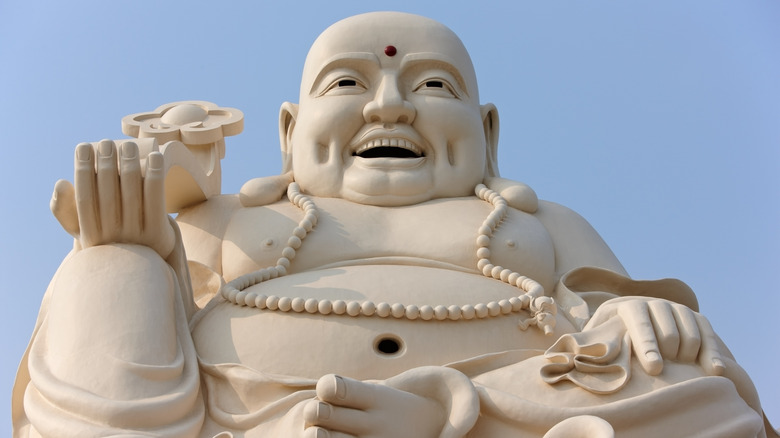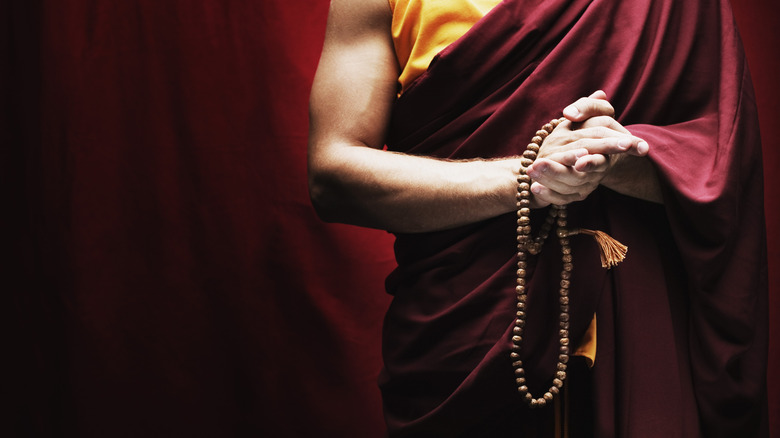What Are The 3 Marks Of Existence In Buddhism?
Have you ever noticed that important things sometimes seem to come in threes? The number three implies a beginning, a middle, and an end, and often suggests a pattern (via The Book of Threes). For a number of reasons, groupings of threes, or triads, are satisfying and symmetrical and that effect shows up in many of the world's religions, in which trios of concepts are often used to explain important spiritual teachings.
In Christianity, for example, there's the holy trinity of the father, the son, and the holy ghost. In Islam, the Sunnah, a holy book, is broken up into three parts (per Richmond Law Library). In Buddhism — an ancient Indian religion practiced worldwide with most Buddhists living in Far East nations (via Pew Research) — there's something called the three marks of existence central to Buddhist spirituality and philosophy: dukkha, anatta, and anicca — here's what those three words mean.
Anicca means impermanence, dukkha means suffering
According to Tricycle: Buddhism for Beginners, the three marks of existence are most common in the Buddhist schools of Theravada and Mahayana. Though varying somewhat depending on the location, there are primarily three major schools of Buddhist thought — there's that number three again — the two already mentioned, and add to that list, Vajrayana, or Tibetan Buddhism, as Buddho.org explains. In most Buddhist traditions, anicca loosely translates to the fleeting nature of everything, impermanence, or that everything falls apart, a notion echoed in Western science by the word entropy.
In Buddhist thought, an acceptance that everything dies and nothing lasts is crucial on the path to true enlightenment. The next term in the Buddhist three marks of existence is dukkha which means something like suffering or dissatisfaction (via BBC). In Buddhist teachings, understanding the concept of dukkha — the idea that all of existence carries with it some sense of discomfort, sadness, or pain — is another step on the path to nirvaṇa, the Buddhist concept in which dukkha and samsara — or the infinite cycle of birth, life, and death to the point of dull repetition with no beginning or end — can finally be overcome, as Oxford Bibliographies writes.
Anatta means there is no true self
No follower of Buddhism will be able to reach nirvana without the third mark of existence: anatta, as Tricycle goes on to note. Anatta could be described in terms of the Western question: Which is more important as far as who we are, nature — or the biological, genetic core we're born with — or nurture, whether each individual's set of unique circumstances both negative and positive have a bigger influence on the people we one day become (via VeryWellMind). In Buddhist thought, our life experience takes the upper hand, summed up by anatta, or the idea that there is no true individual or self.
We're all a product of our life experiences, according to Buddha's teachings, and coming to terms with that fact, along with an acceptance of both anicca and dukkha, are steps along the way to true spiritual enlightenment (per LionsRoar). Certain Buddhists include nirvana itself as a fourth stop in the cycle of existence. Acclaimed Vietnamese Buddhist monk, author, and teacher, Thích Nhất Hạnh, for example, includes nirvana rather than dukkha or suffering in the three marks of existence, or Dharma Seals, according to Opening Heart Mindfulness.


